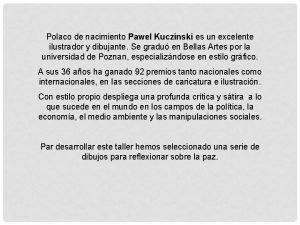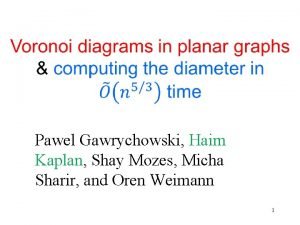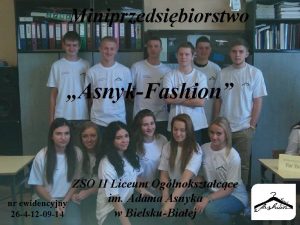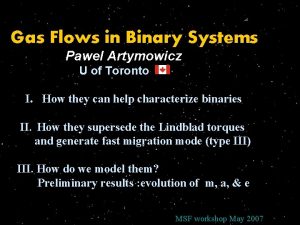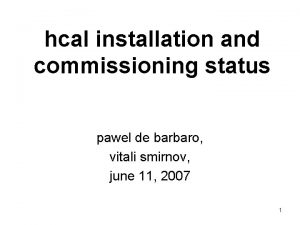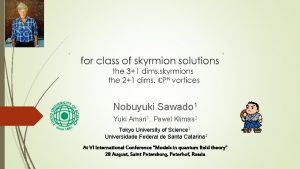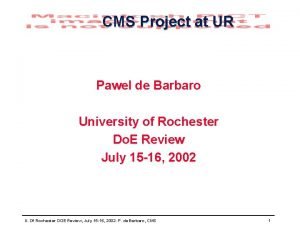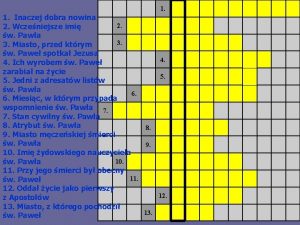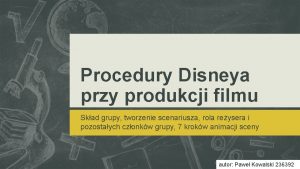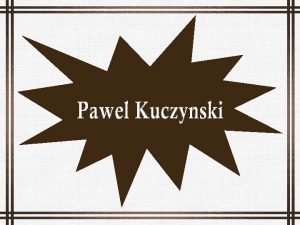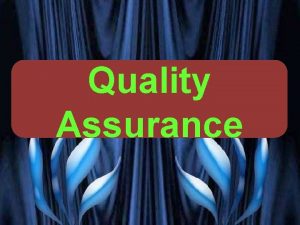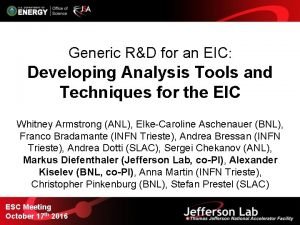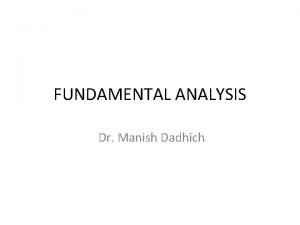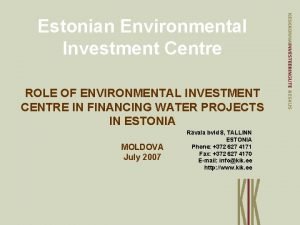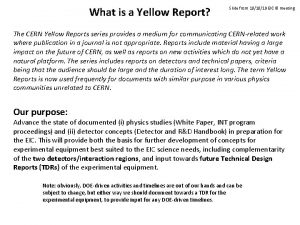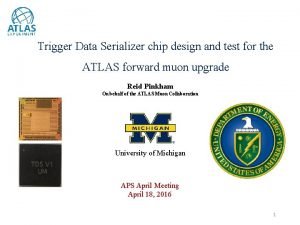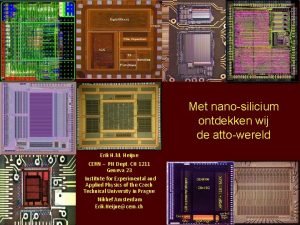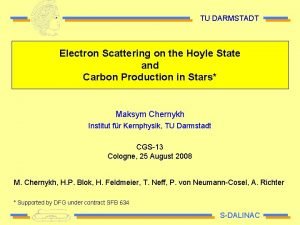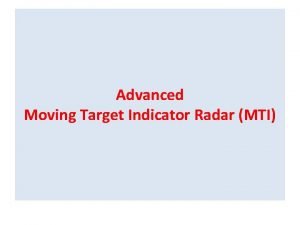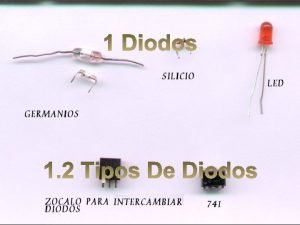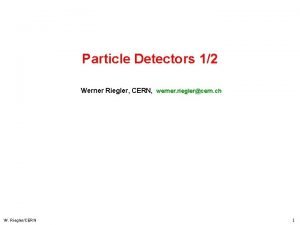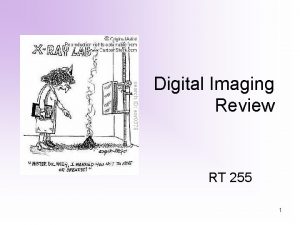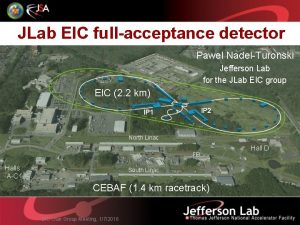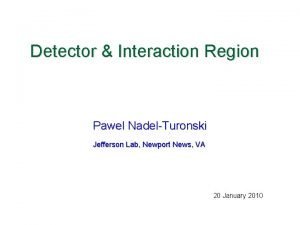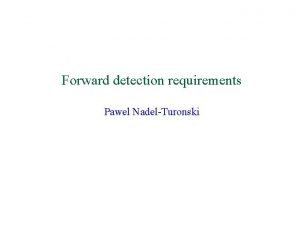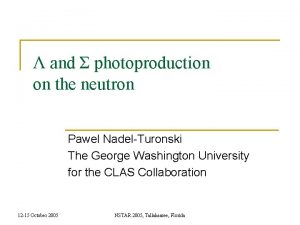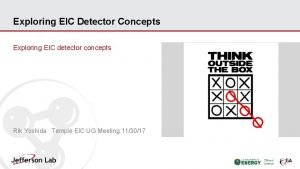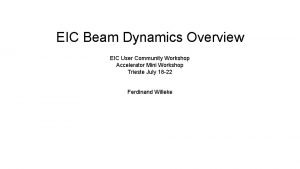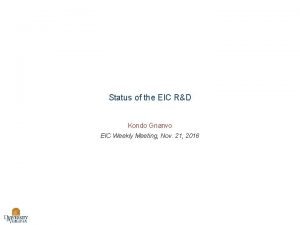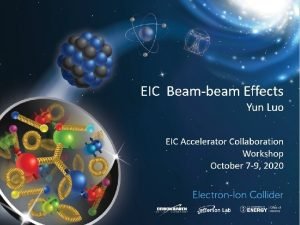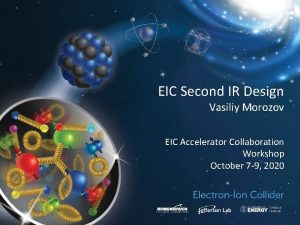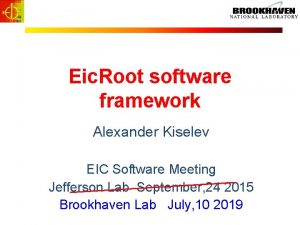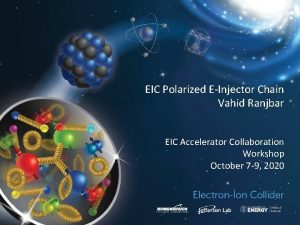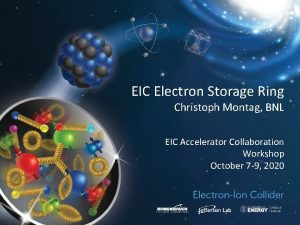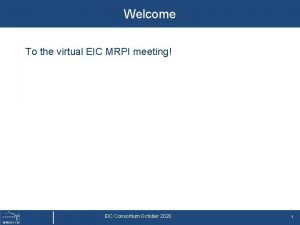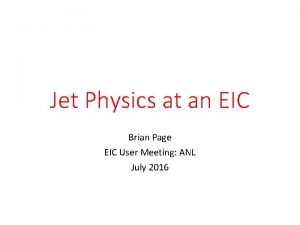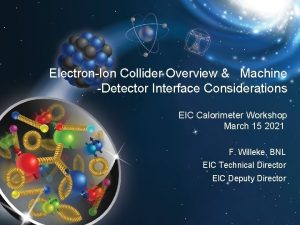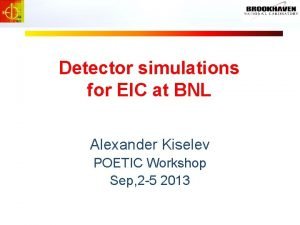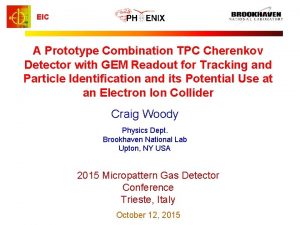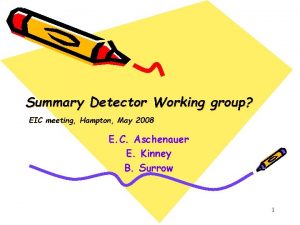EIC detector overview Pawel NadelTuronski EIC 2 2



























- Slides: 27

EIC detector overview Pawel Nadel-Turonski EIC (2. 2 km) IP 1 IP 2 North Linac FEL Halls A-C South Linac CEBAF (1. 4 km racetrack) EIC Friday meeting 3/11/2016 Hall D

Detector locations and backgrounds • IP locations reduce synchrotron- and hadronic backgrounds • Far from arc where electrons exit (synchrotron) • Close to arc where ions exit (hadronic) – shown below • Scaling from HERA (pp cross section, multiplicity, current) suggest comparable hadronic background at similar vacuum • But it should be possible to reach better vacuum! (early HERA: 10 -7, PEP-II: 10 -9, LHC 10 -10 torr) • EIC luminosity is more than 100 times higher • Signal-to-background (random hadronic) should be 103 -104 times better than HERA Detector • Crossing angle and soft bends reduce synchrotron radiation at IP EIC Friday meeting 3/11/2016 2

Detector and interaction region p (top view in GEANT 4) low-Q 2 electron detection and Compton polarimeter Forward hadron spectrometer Extended detector: 70+ m (accelerator view) EIC Friday meeting 3/11/2016 3 e ZDC

Detector overview and design goals p (top view in GEANT 4) low-Q 2 electron detection and Compton polarimeter Central detector Forward hadron spectrometer Electron Polarimetry Low-Q 2 tagger Lumi monitor ~55 mrad bend 1. Detection/identification of complete final state 3. Low-Q 2 electron tagger for photoproduction 4. Compton polarimeter with e- and γ detection EIC Friday meeting 3/11/2016 4 ZDC Forward hadron spectrometer Design goals: 2. Spectator p. T resolution << Fermi momentum e ZDC for neutrals

Central detector – design considerations Modular design, compatible with CLEO and Ba. Bar 1. 5 T solenoids, or a new 3 T solenoid IP 1 detector 10. 5 m quad-to-quad 4 m long coil, 3 m diameter FOM ~ BR 2 for tracking in barrel Mid-rapidity tracking resolution is not an issue if R is utilized well Luminosity ~ 1 / (total distance) between ion quadrupoles Stat. error ~ √(distance) Important, but not at the 10% level Endcap space allocation should be driven by physics, not accelerator Same conclusion for ring-ring e. RHIC Focus on reconstruction and identification of individual particles EIC physics requires very good PID 4π Hcal for high-multiplicity jets at IP 1 possible but… At least one detector must provide it! Most challenging requirement - drives layout and size of the central detector EIC Friday meeting 3/11/2016 Important for 3 D structure (exclusive, SIDIS), heavy flavor (+ spectroscopy) low-multiplicity jets, etc 5 a supplementary, calorimetric IP 2 detector may be available (s. PHENIX)

Central detector – key features Doubly asymmetric: IP location within solenoid and different endcaps Maximizes solid angle for electron endcap More space for tracking and ID of high-momentum forward-going particles Makes full use of 50 mrad crossing angle and 2 Tm (conical) dipole for small-angle tracking Magnetic field satisfies both tracker and dual-radiator RICH requirements Solenoid field can be adjusted independently of the beam energies Central tracker EIC Friday meeting 3/11/2016 6 RICH

Central detector overview 4. 4 m solenoid coil mirrors Central tracker (low-mass DC) Dualradiator RICH EMcal (Shashlyk) Endcap GEM trackers GEMC implementation by Zhiwen Zhao 5 m 3. 2 m electron endcap CF 4 TOF Vertex (Si pixel) aerogel DIRC & TOF Endcap tracker (TRD? ) EMcal ( PWO) e/π Cherenkov (HBD with r. TPC? ) TO F EMcal (Sci-Fi) central barrel EIC Friday meeting 3/11/2016 hadron endcap 7 Hcal (iron) PWO 4 EMcal (NPS) GEM trackers dipole Space for additional muon chamber ors (top view) Emcal (Shaslyk) Muon chambers (flux return yoke) Fluxreturn coils sens Flux-return coils Modular aerogel RICH 2 m

Generic EIC detector R&D program al c EM uter Electron endcap O al c M r. E CH ne In EM cal ge o M TO F ter Ou r la du ro ae e. RD 14 – modular aerogel RICH I l. R ov nk BD H or e er Ch e/π e. RD 1 – PWO 4 smallangle EMcal s er k ac M GE tr l ra nt er e C ack tr x rte er e V ack tr e. RD 6 – HBD/TPC? e. RD 3 & e. RD 6 – GEM trackers e. RD 14 – DIRC BNL & JLab staff and users actively participate in the program JLab detector implements many of the projects in its baseline Program is managed by T. Ullrich (BNL) and open to everyone EIC Friday meeting 3/11/2016 8 e. RD 14 – MRPC TOF e. RD 14 – photosensors e. RD 14 – dualradiator RICH

Central detector solenoid and dipole Paul Brindza EIC Friday meeting 3/11/2016 9

Magentic field (magnitude) Paul Brindza EIC Friday meeting 3/11/2016 10

Field perp to line of sight from IP (hadron) (Y*Bz-Z*By)sqrt(Z*Z+Y*Y) 3 < theta < 26. 5 degrees RICH: CF 4 @ 2. 5 m Paul Brindza EIC Friday meeting 3/11/2016

Hadron identification requirements • h-endcap: momentum range driven by proton beam energy. • e-endcap: momentum range driven by electron beam energy. – Need to cover significant fraction • A dual-radiator RICH can do π/K up to 50 Ge. V/c – Need to cover range up to almost full electron energy – ) • A (modular) aerogel RICH can do π/K up to 10 Ge. V • 4π TOF coverage is needed for bunch identification – and coincidence with small -angle detectors • Time resolution of 30 -50 ps also gives limited hadron ID • barrel: required momentum range for π/K is about half the electron beam energy. • A DIRC can cover π/K up to at least 4 Ge. V/c – R&D ongoing to extend the momentum range to 6 Ge. V/c EIC Friday meeting 3/11/2016 12

Electron identification requirements • h-endcap: EMcal + Hcal cover full range • Pion backgrounds are large at small angles (endcaps) and low energies. • – Need suppression at the 103 – 104 – EMcal alone not enough – CF 4 RICH can provide additional e/π ID at low energy An additional TRD would help suppress backgrounds for leptonic decays of reaction products (ofen high energies) • e-endcap: EMcal covers full range • A Hadron Blind Detector (Cherenkov) provides additional e/π ID up to 4 Ge. V/c. • Inner PWO 4 has 2%/√E resolution vs 5 -6%/√E for the outer Shashlyk • Important for reconstruction of electron momentum at small angles! • barrel: Pion backgrounds smaller. • Glue. X-like Sci-Fi EMcal provides factor 100 suppresion • A high-performance DIRC can provide additional e/π ID EIC Friday meeting 3/11/2016 up to 1. 8 Ge. V/c (which corresponds to 6 Ge. V/c for π/K) 13

Forward hadron spectrometer Compensating solenoid and 20 Tm dipole tracker 2 Tm dipole Aperture-free drift space high-res. ZDC (n, Forward hadron spectrometer solenoid 50 mrad crossing angle (Belle II: 83 mrad) S-shaped dipole configuration optimizes neutron acceptance and beam line separation (> 1 m) Spectator protons (exit windows) IP (primary focus) EIC Friday meeting 3/11/2016 p e Recoil protons (e. g. DVCS) (roman pots at focal point) Spectator proton angle after dipole is 75 mrad (from beam) ions ion optics 2 nd focus on Roman pots γ) • • Large 20 Tm dipole provides excellent resolution • Large quadrupole apertures (1 / max beam energy) give good acceptance for hadronic and nuclear fragments, charged and neutral (high res. ZDC). Large dispersion and small beam size at secondary focus ensure good acceptance for recoil baryons 14

Fragment acceptance and resolution dp/p proton-rich fragments “spectator protons from 2 H” • Full acceptance for all partonic and nuclear fragments achieved! neutron-rich fragments “tritons from N=Z nuclei” – Low gradient, large aperture magnets (quadrupoles) • Detector resolution designed to be better than intrinsic momentum and angular spread of the beam – Longitudinal (dp/p): few x 10 -4 – Angular (θ, for all φ): < 0. 3 mrad Forward charged-particle acceptance horizontal plane Scattering angle at IP (degrees) +1° vertical plane Neutron acceptance (x and y): 25 mrad cone +1° Red: Red Detection before ion quadrupoles Blue: Blue Detection after ion quadrupoles -1° EIC Friday meeting 3/11/2016 -1° 15 +1°

Spectator tagging & neutron structure K Park et al. On-shell extrapolation of F 2 n ZDC Tagged spectator protons (no lower limit since rigidity is different than the beam) EIC Friday meeting 3/11/2016 16 Requires resolution better than Fermi momentum (< 20 Me. V/c) Resolution scales with p JLab design can reach 20 Me. V/c even with 50 Ge. V/A deuterium!

JLab: DVCS recoil proton acceptance Kinematics: 5 Ge. V e- on 100 Ge. V p at a crossing angle of 50 mrad. Cuts: Q 2 > 1 Ge. V 2, x < 0. 1, E’e > 1 Ge. V, recoil proton 10σ outside of beam GEANT 4 simulation: tracking through magnets done using GEMC low-t acceptance high-t acceptance High-t acceptance limited by magnet apertures p beam at 50 mrad Proton angle at IP (beam separation not an issue with 50 mrad crossing angle) Acceptance with 10σ beam size cut: -tmax = 1. 9 Ge. V 2 ± 14 mrad p < 99. 5% of beam for all angles θ > 2 mrad for all momenta e- beam at 0 mrad Recoil proton angle is independent of electron beam energy: θp ≈ p. T/Ep ≈ √(-t)/Ep The ion beam size (focusing, emittance, cooling) introduces a low-p. T (-t) cutoff Larger cone at lower Ep pushes the low-t cutoff lower, and make precise tracking easier EIC Friday meeting 3/11/2016 17

Compton polarimeter and low-Q 2 tagger Experience from HERA: uncertainty ~ 1. 4% Limited to detection of Compton photon only Accelerator limitations (non-colliding bunches) Experience from JLab and SLAC SLD at SLAC reached 0. 5% detecting the Compton electron Compton polarimeters in Halls A/C at JLab reach << 1% detecting both γ and e Polarization at center of chicane exactly that same as at IP! Laser at chicane center and symmetric dipoles cancelling net spin precession Compton photon detector - calorimeter and/or pair spectrometer JLab EIC Compton / low-Q 2 / luminosity chicane Laser γc Low-Q 2 tagger for high-energy electrons e- beam to spin rotator Compton electron tracking detector Compton- and low-Q 2 electrons are kinematically separated! EIC Friday meeting 3/11/2016 18 Low-Q 2 tagger for low-energy electrons Luminosity monitor (from SLAC? ) ebeam from IPfrom Photons IP

Compton/low-Q 2 chicane layout or pair spectrometer Luminosity monitor Low-Q 2 tagger in GEANT 4 EIC Friday meeting 3/11/2016 19

Summary EIC Friday meeting 3/11/2016 20

Backup EIC Friday meeting 3/11/2016 21

Updated forward spectrometer optics ~14. 4 m 4 m D’ ~ 0 D = 0, D’ = 0 x , y < ~0. 6 m middle of straight limit x and y Vasiliy Morozov EIC Friday meeting 3/11/2016

“TPC” region ~ delta B/B ~ 3 % (0<R<40 cm, -30<Z<70 cm) IP is (0, 0) Paul Brindza EIC Friday meeting 3/11/2016

Field perp to line of sight from IP (electron) (Y*Bz-Z*By)sqrt(Z*Z+Y*Y) 3 < theta < 26. 5 degrees Paul Brindza EIC Friday meeting 3/11/2016

Revised e. PHENIX/CELESTE concept N. Feege, EIC UG meeting, Jan 2016 EIC Friday meeting 3/11/2016 25

Be. AST detector (BNL) A. Kiselev, EIC UG meeting, Jan 2016 -4<h<4: Tracking & e/m Calorimetry (hermetic coverage) hadronic calorimeters SBS e/m calorimeters RICH detectors 9. 0 m CBM EIC R&D (UCLA, BNL) ons tr elec EIC R&D (UCLA, BNL) ALICE ro had EIC Friday meeting 3/11/2016 ns silicon trackers 26 TPC GEM trackers 3 T solenoid coils

The four “universal” ion beam energies Ge. V/A (or % of max proton energy) 100 p 66. 7 3 He 57. 1 Interesting ions Light nuclei: d, 3 He, 9 Be Mirror nuclei 7 Be, 7 Li Magic nuclei: α, 16 O, 40 Ca, 208 Pb Non-spherical heavy nuclei: 238 U 7 Be N=Z nuclei, incl. d, α, 6 Li, 12 C, 16 O, 40 Ca 50 41. 6 38. 6 48 Ca 44. 4 42. 8 39. 4 9 Be, 90 Zr 33. 3 t 7 Li 208 Pb 238 U The baseline EIC program can be completed using only four energies Protons will be run at all four, ions at and/or below their max energy EIC Friday meeting 3/11/2016 27
 Pawel kuczinski
Pawel kuczinski Pawel gawrychowski
Pawel gawrychowski Ilustraciones pawel kuczynski
Ilustraciones pawel kuczynski Paweł pyś
Paweł pyś Pawel artymowicz
Pawel artymowicz Pawel de barbaro
Pawel de barbaro Yuki amari
Yuki amari Pawel de barbaro
Pawel de barbaro Dobra nowina krzyżówka religia
Dobra nowina krzyżówka religia Pawel kowalski
Pawel kowalski Pawel kuczynski apple
Pawel kuczynski apple Pawel okonski
Pawel okonski Yellow report eic
Yellow report eic Qa eic patel
Qa eic patel Export inspection agency health certificate
Export inspection agency health certificate Eic software software review
Eic software software review Eic approach of fundamental analysis
Eic approach of fundamental analysis Eic european investment centre
Eic european investment centre Kickoff meting
Kickoff meting Eic fiu
Eic fiu Txp100
Txp100 Timepix
Timepix Colour code detector
Colour code detector Moving target detector
Moving target detector Diodo backward aplicaciones
Diodo backward aplicaciones Werner riegler cern
Werner riegler cern Scintillator x-ray
Scintillator x-ray Adaboostclassifier
Adaboostclassifier
